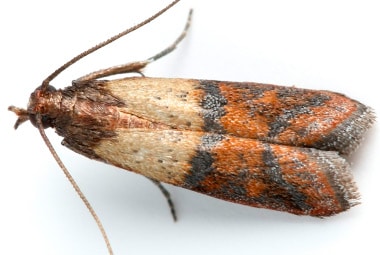
One of the more common household pests, the Indian meal moth earned its name in the United States by feeding on meal made from Indian corn. They often come into your home in packaged goods like flour, grains, cereals and even pet food. If you spot a moth darting around in your kitchen or pantry, it’s almost a sure bet that it will be an Indian meal moth.
| Pest Identification | |
|---|---|
| Recognition | The Indian meal moth is a small but rather attractive looking moth averaging 3/8 inch in length with a wingspan of approximately ¾ inch. It is easily recognized from other pantry pests by the unique markings on the forewings. The wings are a reddish brown with a copper luster on the outer 2/3 of the wing and a white or gray color on the inner or body ends of the wings. The inner wings do not boast of color variations and are simply gray in color. |
| Biology | The adult Indian meal moth lives approximately 6 days with their total function being reproduction. One female can lay anywhere from 300-500 microscopic eggs in a period of about 18 days. The larvae look like off-white worms with a brown head. The lifespan of the larva stage varies and is temperature driven. All damage is done once it enters into the pupa stage. Total life cycle from egg to egg varies greatly as well with a span of anywhere from 25 days to 135 days depending on temperature and food availability. |
| Habits | The Indian meal moth is predominately nocturnal. However, the adult is attracted to lights and can be seen flying around at night. The adult causes no harm or damage to food items and literally spends its entire 6 days of life reproducing. The larvae are the inflictors of damage. They feed on every food imaginable plus pet food, flowers, potpourri and even rodent bait. The larvae do considerable damage contaminating food as they spin large amounts of silken webbing over the food sources. The webbing collects fecal matter and shed skins. The waste from contamination is greater than the amount of food consumed. |
| Prevention | The best control strategy begins with prevention. Cleanliness and sanitation will greatly minimize the need for pesticides. These sanitation practices include the removal of all crumbs and spilled food products. Examine all food containers and discard any infested food items. Place unused pantry foods in pest-proof containers. Many Indian meal moths make their appearance into your kitchen and pantry from food sources carried into the house. Examine all packages prior to storing them in the pantry. Vacuum pantry shelves and floor to remove any larvae, pupae and eggs. This also helps in removing any potential food sources. |
| Professional | The most effective approach to remove the threat of an Indian meal moth infestation is with the help of a professional. Your Rottler pest management technician will locate the breeding sources as well as controlling any current infestation. He will also make recommendations to help prevent a re-occurrence of Indian meal moths. |

